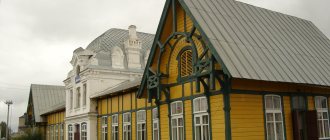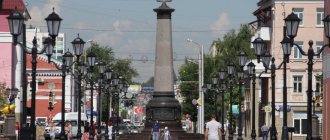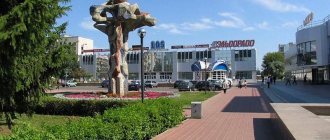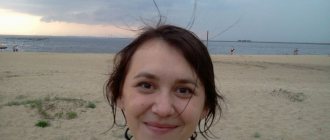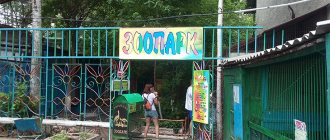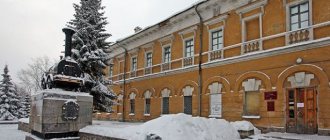City of Dolinsk, Sakhalin region
Urban Okrug "Dolinsky" is a municipal formation in the Sakhalin region of Russia, created within the boundaries of the administrative-territorial unit of the Sakhalin region - Dolinsky district.
The administrative center is the city of Dolinsk.
The city of Dolinsk is the regional center of the Sakhalin region. The name of the city was given by the Decree of the Presidium of the Supreme Soviet of the RSFSR dated June 15, 1946. It is located in the Susunai Valley at the confluence of three rivers - Dolinka, Bolshoi Takoya and Naiba (the Ainu name of the river is Naibuchi).
The history of the city begins with the founding of the military post of Naibuchi in 1867, at the mouth of the Naiba River near two Ainu villages of Sianchi (sometimes called Siyantsi) and Otakoe (now called Takoe). During the time of Chekhov, the village of Galkino-Vrasskoye (named after the head of the Main Prison Directorate) was part of the Korsakov District. In the place where the village of Sianchi was located, the city is located today.
According to the First All-Russian Census, in 1897 115 people already lived here. There were 53 farms in the village, with 115 different buildings. Agricultural land included 18 acres of estate land and 62 acres of arable land.
In 1911, a railway was built from Toyohara (Yuzhno-Sakhalinsk) to the north, which passed through Ochiai. In 1915, 250 people lived in the village, and after the construction of a paper mill, the population increased sharply and amounted to several thousand people.
Since 1922, Otiai has become a city of regional significance. Construction of the railway north to Terpeniya Bay continues, and highways are being laid. Coal and paper industries are being created. The population of Ochiai in 1927 was 10,639 people.
In the period from 1905 to 1945 the city was part of Japan. Until 1946 it was called Otiai. The name may be from the Japanese ochi "valley, dell", which seems to be due to its location in a valley.
Since 1945, again part of Russia (USSR).
In 1956, the dairy plant came into operation, almost all production processes at the plant were mechanized. The production of a wide range of dairy products was mastered, including the production of cream, sour cream and cottage cheese, kefir, curdled milk, cheese curds and several types of ice cream.
By 1957, five settlements in the region were radio-connected; in 1956, 3,330 radio points and 2,100 receivers were registered.
In 1966, a new bread store “Kolobok” and a cafe were opened in the city, a number of stores were overhauled and re-equipped. In the same year, at the exhibition and sale of products held in Yuzhno-Sakhalinsk, products produced by meat processing plants in the regional center, Korsakov, Makarov and Dolinsk were also presented. Dolinskoye beer of the Zhigulevskoye brand was recognized by experts as the best. Soft drinks, produced in Dolinsk in a very rich assortment, were also in great demand.
The arboretum of the Sakhalin Forest Research Station located in the city has collected and presented 170 species of tree and shrub plants of the Sakhalin region. The forest is a continuation of the green zone of the city.
In past years, the pulp and paper industry occupied a leading place in the city's economy. The Dolinsky plant was one of the largest paper factories in the USSR and produced various types of paper for the whole country. However, today the plant is closed, only the boiler room remains, which heats the city in winter. The factory building was present on the Soviet coat of arms of Dolinsk (it was no longer included in the new coat of arms of the pulp and paper mill).
Since January 1, 2005, the Dolinsky district has been given the status of the municipal district of the Dolinsky urban district, consisting of the following settlements: the city of Dolinsk and 13 villages: Arsentyevka, Bykov, Vzmorye, Oktyabrskoye, Pokrovka, Ruchi, Sovetskoye, Sokol, Sosnovka, Starodubskoye, Uglezavodsk and Firsovo.
The population of the Russian Federation by municipalities as of January 1, 2016 is 11,751 people.
The coat of arms was approved on April 26, 2002. It depicts a green-azure field beveled on the left with a silver scaly thread. In a green field are three silver lilies on stems with leaves (two on the right, one on the left), accompanied at the top left by a silver band; in an azure field there is a silver eagle facing to the right with raised wings, holding a golden fish in its claws with its head to the left.
The flag was approved on February 27, 2006 as the flag of the municipal formation “Dolinsky District”. Compiled on the basis of the coat of arms according to the rules and relevant traditions of heraldry and reflects historical, cultural, socio-economic, national and other local traditions.
Dolinsk
(Sakhalin region)
OKATO code:
64212501
Founded:
1884
City since:
1946 City of regional subordination
Center:
Dolinsky district
The city was formerly called:
| Galkino-Vrasskoe | 1884 | 1905 |
| Ochiai | 1905 | 1946 |
| Telephone code (reference phone) | |
| 42442***** | — |
Deviation from Moscow time, hours:
8
Geographical latitude:
47°19′
Geographical longitude:
142°48′
Altitude above sea level, meters:
20 Sunrise and sunset times of the Sun and Moon in the city of Dolinsk
Excerpt characterizing Dolinsk
Rostov let his horse go and wanted to ride on. A wounded officer walking past turned to him. -Who do you want? – asked the officer. - Commander-in-Chief? So he was killed by a cannonball, killed in the chest by our regiment. “Not killed, wounded,” another officer corrected. - Who? Kutuzov? - asked Rostov. - Not Kutuzov, but whatever you call him - well, it’s all the same, there aren’t many alive left. Go over there, to that village, all the authorities have gathered there,” said this officer, pointing to the village of Gostieradek, and walked past. Rostov rode at a pace, not knowing why or to whom he would go now. The Emperor is wounded, the battle is lost. It was impossible not to believe it now. Rostov drove in the direction that was shown to him and in which a tower and a church could be seen in the distance. What was his hurry? What could he now say to the sovereign or Kutuzov, even if they were alive and not wounded? “Go this way, your honor, and here they will kill you,” the soldier shouted to him. - They'll kill you here! - ABOUT! what are you saying? said another. -Where will he go? It's closer here. Rostov thought about it and drove exactly in the direction where he was told that he would be killed. “Now it doesn’t matter: if the sovereign is wounded, should I really take care of myself?” he thought. He entered the area where most of the people fleeing from Pratsen died. The French had not yet occupied this place, and the Russians, those who were alive or wounded, had long abandoned it. On the field, like heaps of good arable land, lay ten people, fifteen killed and wounded on every tithe of space. The wounded crawled down in twos and threes together, and one could hear their unpleasant, sometimes feigned, as it seemed to Rostov, screams and moans. Rostov started to trot his horse so as not to see all these suffering people, and he became scared. He feared not for his life, but for the courage that he needed and which, he knew, would not withstand the sight of these unfortunates. The French, who stopped shooting at this field strewn with the dead and wounded, because there was no one alive on it, saw the adjutant riding along it, aimed a gun at him and threw several cannonballs. The feeling of these whistling, terrible sounds and the surrounding dead people merged for Rostov into one impression of horror and self-pity. He remembered his mother's last letter. “What would she feel,” he thought, “if she saw me now here, on this field and with guns pointed at me.” In the village of Gostieradeke there were, although confused, but in greater order, Russian troops marching away from the battlefield. The French cannonballs could no longer reach here, and the sounds of firing seemed distant. Here everyone already saw clearly and said that the battle was lost. Whoever Rostov turned to, no one could tell him where the sovereign was, or where Kutuzov was. Some said that the rumor about the sovereign’s wound was true, others said that it was not, and explained this false rumor that had spread by the fact that, indeed, the pale and frightened Chief Marshal Count Tolstoy galloped back from the battlefield in the sovereign’s carriage, who rode out with others in the emperor’s retinue on the battlefield. One officer told Rostov that beyond the village, to the left, he saw someone from the higher authorities, and Rostov went there, no longer hoping to find anyone, but only to clear his conscience before himself. Having traveled about three miles and having passed the last Russian troops, near a vegetable garden dug in by a ditch, Rostov saw two horsemen standing opposite the ditch. One, with a white plume on his hat, seemed familiar to Rostov for some reason; another, unfamiliar rider, on a beautiful red horse (this horse seemed familiar to Rostov) rode up to the ditch, pushed the horse with his spurs and, releasing the reins, easily jumped over the ditch in the garden. Only the earth crumbled from the embankment from the horse’s hind hooves. Turning his horse sharply, he again jumped back over the ditch and respectfully addressed the rider with the white plume, apparently inviting him to do the same. The horseman, whose figure seemed familiar to Rostov and for some reason involuntarily attracted his attention, made a negative gesture with his head and hand, and by this gesture Rostov instantly recognized his lamented, adored sovereign. “But it couldn’t be him, alone in the middle of this empty field,” thought Rostov. At this time, Alexander turned his head, and Rostov saw his favorite features so vividly etched in his memory. The Emperor was pale, his cheeks were sunken and his eyes sunken; but there was even more charm and meekness in his features. Rostov was happy, convinced that the rumor about the sovereign’s wound was unfair. He was happy that he saw him. He knew that he could, even had to, directly turn to him and convey what he was ordered to convey from Dolgorukov. But just as a young man in love trembles and faints, not daring to say what he dreams of at night, and looks around in fear, looking for help or the possibility of delay and escape, when the desired moment has come and he stands alone with her, so Rostov now, having achieved that , what he wanted more than anything in the world, did not know how to approach the sovereign, and he was presented with thousands of reasons why it was inconvenient, indecent and impossible. "How! I seem to be glad to take advantage of the fact that he is alone and despondent. An unknown face may seem unpleasant and difficult to him at this moment of sadness; Then what can I tell him now, when just looking at him my heart skips a beat and my mouth goes dry?” Not one of those countless speeches that he, addressing the sovereign, composed in his imagination, came to his mind now. Those speeches were mostly held under completely different conditions, they were spoken for the most part at the moment of victories and triumphs and mainly on his deathbed from his wounds, while the sovereign thanked him for his heroic deeds, and he, dying, expressed his love confirmed in fact my. “Then why should I ask the sovereign about his orders to the right flank, when it is already 4 o’clock in the evening and the battle is lost? No, I definitely shouldn’t approach him. Shouldn't disturb his reverie. It’s better to die a thousand times than to receive a bad look from him, a bad opinion,” Rostov decided and with sadness and despair in his heart he drove away, constantly looking back at the sovereign, who was still standing in the same position of indecisiveness. While Rostov was making these considerations and sadly driving away from the sovereign, Captain von Toll accidentally drove into the same place and, seeing the sovereign, drove straight up to him, offered him his services and helped him cross the ditch on foot. The Emperor, wanting to rest and feeling unwell, sat down under an apple tree, and Tol stopped next to him. From afar, Rostov saw with envy and remorse how von Tol spoke for a long time and passionately to the sovereign, and how the sovereign, apparently crying, closed his eyes with his hand and shook hands with Tol. “And I could be in his place?” Rostov thought to himself and, barely holding back tears of regret for the fate of the sovereign, in complete despair he drove on, not knowing where and why he was going now. His despair was the greater because he felt that his own weakness was the cause of his grief. He could... not only could, but he had to drive up to the sovereign. And this was the only opportunity to show the sovereign his devotion. And he didn’t use it... “What have I done?” he thought. And he turned his horse and galloped back to the place where he had seen the emperor; but there was no one behind the ditch anymore. Only carts and carriages were driving. From one furman, Rostov learned that the Kutuzov headquarters was located nearby in the village where the convoys were going. Rostov went after them. The guard Kutuzov walked ahead of him, leading horses in blankets. Behind the bereytor there was a cart, and behind the cart walked an old servant, in a cap, a sheepskin coat and with bowed legs. - Titus, oh Titus! - said the bereitor. - What? - the old man answered absentmindedly. - Titus! Go threshing. - Eh, fool, ugh! – the old man said, spitting angrily. Some time passed in silent movement, and the same joke was repeated again. At five o'clock in the evening the battle was lost at all points. More than a hundred guns were already in the hands of the French. Przhebyshevsky and his corps laid down their weapons. Other columns, having lost about half of the people, retreated in frustrated, mixed crowds. The remnants of the troops of Lanzheron and Dokhturov, mingled, crowded around the ponds on the dams and banks near the village of Augesta. At 6 o'clock only at the Augesta dam the hot cannonade of the French alone could still be heard, who had built numerous batteries on the descent of the Pratsen Heights and were hitting our retreating troops. In the rearguard, Dokhturov and others, gathering battalions, fired back at the French cavalry that was pursuing ours. It was starting to get dark. On the narrow dam of Augest, on which for so many years the old miller sat peacefully in a cap with fishing rods, while his grandson, rolling up his shirt sleeves, was sorting out silver quivering fish in a watering can; on this dam, along which for so many years the Moravians drove peacefully on their twin carts loaded with wheat, in shaggy hats and blue jackets and, dusted with flour, with white carts leaving along the same dam - on this narrow dam now between wagons and cannons, under the horses and between the wheels crowded people disfigured by the fear of death, crushing each other, dying, walking over the dying and killing each other only so that, after walking a few steps, to be sure. also killed. Every ten seconds, pumping up the air, a cannonball splashed or a grenade exploded in the middle of this dense crowd, killing and sprinkling blood on those who stood close. Dolokhov, wounded in the arm, on foot with a dozen soldiers of his company (he was already an officer) and his regimental commander, on horseback, represented the remnants of the entire regiment. Drawn by the crowd, they pressed into the entrance to the dam and, pressed on all sides, stopped because a horse in front fell under a cannon, and the crowd was pulling it out. One cannonball killed someone behind them, the other hit in front and splashed Dolokhov’s blood. The crowd moved desperately, shrank, moved a few steps and stopped again. Walk these hundred steps, and you will probably be saved; stand for another two minutes, and everyone probably thought he was dead. Dolokhov, standing in the middle of the crowd, rushed to the edge of the dam, knocking down two soldiers, and fled onto the slippery ice that covered the pond. “Turn,” he shouted, jumping on the ice that was cracking under him, “turn!” - he shouted at the gun. - It’s holding!... The ice was holding it, but it was bending and cracking, and it was obvious that not only under a gun or a crowd of people, but under him alone, it would now collapse. They looked at him and huddled close to the shore, not daring to step on the ice yet. The regiment commander, standing on horseback at the entrance, raised his hand and opened his mouth, addressing Dolokhov. Suddenly one of the cannonballs whistled so low over the crowd that everyone bent down. Something splashed into the wet water, and the general and his horse fell into a pool of blood. No one looked at the general, no one thought to raise him.
Notes
- ↑ 123
www.gks.ru/free_doc/doc_2016/bul_dr/mun_obr2016.rar Population of the Russian Federation by municipalities as of January 1, 2016 - [www.russianpost.ru/PostOfficeFindInterface/FindOPSByPostOfficeID.aspx?index=694051 Information about the post office on the Russian Post website]
- [dolinsk-sakh.narod.ru/index.html Website of the city of Dolinsk]
- [www.dolinsksite.ru/history History of the Municipal Municipality "Dolinsky"]. 2011-01-13
. Administration of the municipal district "Dolinsky". Retrieved June 30, 2012. [www.webcitation.org/69gM8E9IO Archived from the original on August 5, 2012]. - [dolinsk-sakh.narod.ru/geo-dolinsk.html city of Dolinsk]. Website of the city of Dolinsk (April 1, 2010). Retrieved October 24, 2014. [www.webcitation.org/68f5rvbZ8 Archived from the original on June 24, 2012].
- Administration of the governorate of Karafuto.
[kindai.ndl.go.jp/info:ndljp/pid/975896 1925 Census Results: Households and Population]. - Toyohara, 1926. - pp. 18-27. — 30 s. - Administration of the governorate of Karafuto.
[kindai.ndl.go.jp/info:ndljp/pid/1462110 1935 Census Results: Households and Population]. - Toyohara, 1936. - pp. 15-19. — 25 s. - [demoscope.ru/weekly/ssp/rus59_reg2.php All-Union Population Census of 1959. The size of the urban population of the RSFSR, its territorial units, urban settlements and urban areas by gender] (Russian). Demoscope Weekly. Retrieved September 25, 2013. [www.webcitation.org/6GDOghWC9 Archived from the original on April 28, 2013].
- ↑ 1234567891011
www.MojGorod.ru/sahalin_obl/dolinsk/index.html People's encyclopedia “My City”. Dolinsk - [demoscope.ru/weekly/ssp/rus70_reg2.php All-Union Population Census of 1970 The size of the urban population of the RSFSR, its territorial units, urban settlements and urban areas by gender.] (Russian). Demoscope Weekly. Retrieved September 25, 2013. [www.webcitation.org/6GDOiMstp Archived from the original on April 28, 2013].
- [demoscope.ru/weekly/ssp/rus79_reg2.php All-Union Population Census of 1979 The size of the urban population of the RSFSR, its territorial units, urban settlements and urban areas by gender.] (Russian). Demoscope Weekly. Retrieved September 25, 2013. [www.webcitation.org/6GDOjhZ5L Archived from the original on April 28, 2013].
- [demoscope.ru/weekly/ssp/rus89_reg2.php All-Union Population Census of 1989. Urban population]. [www.webcitation.org/617x0o0Pa Archived from the original on August 22, 2011].
- [www.perepis2002.ru/ct/doc/1_TOM_01_04.xls All-Russian Population Census 2002. Volume. 1, table 4. Population of Russia, federal districts, constituent entities of the Russian Federation, districts, urban settlements, rural settlements - regional centers and rural settlements with a population of 3 thousand or more]. [www.webcitation.org/65AdCU0q3 Archived from the original on February 3, 2012].
- [www.gks.ru/bgd/regl/B09_109/IssWWW.exe/Stg/d01/tabl-21-09.xls Number of permanent population of the Russian Federation by cities, urban-type settlements and districts as of January 1, 2009]. Retrieved January 2, 2014. [www.webcitation.org/6MJmu0z1u Archived from the original on January 2, 2014].
- [sakhalinstat.gks.ru/wps/wcm/connect/rosstat_ts/sakhalinstat/resources/b7451680420c302db621fe2d59c15b71/5.pdf All-Russian Population Census 2010. Sakhalin region. Population of urban districts, municipal districts, urban and rural settlements, urban settlements, rural settlements]. Retrieved July 28, 2014. [www.webcitation.org/6RPB9plO8 Archived from the original on July 28, 2014].
- www.gks.ru/dbscripts/munst/munst64/DBInet.cgi?pl=8112027 Sakhalin region. Estimated resident population as of January 1, 2011-2016
- [www.gks.ru/free_doc/doc_2012/bul_dr/mun_obr2012.rar Population of the Russian Federation by municipalities. Table 35. Estimated resident population as of January 1, 2012]. Retrieved May 31, 2014. [www.webcitation.org/6PyOWbdMc Archived from the original on May 31, 2014].
- [www.gks.ru/free_doc/doc_2013/bul_dr/mun_obr2013.rar Population of the Russian Federation by municipalities as of January 1, 2013. - M.: Federal State Statistics Service Rosstat, 2013. - 528 p. (Table 33. Population of urban districts, municipal districts, urban and rural settlements, urban settlements, rural settlements)]. Retrieved November 16, 2013. [www.webcitation.org/6LAdCWSxH Archived from the original on November 16, 2013].
- [www.gks.ru/free_doc/doc_2014/bul_dr/mun_obr2014.rar Table 33. Population of the Russian Federation by municipalities as of January 1, 2014]. Retrieved August 2, 2014. [www.webcitation.org/6RWqP50QK Archived from the original on August 2, 2014].
- [www.gks.ru/free_doc/doc_2015/bul_dr/mun_obr2015.rar Population of the Russian Federation by municipalities as of January 1, 2015]. Retrieved August 6, 2015. [www.webcitation.org/6aaNzOlFO Archived from the original on August 6, 2015].
- Skibina A.G.
[encsakhalin.ru/object/1804669741?lc=ru Orlov Nikolay Kozmich, doctor, Honorary Citizen of Dolinsk].
Healthcare/Personnel
. Encyclopedia of the Sakhalin region. Retrieved November 30, 2013. [www.peeep.us/8407240a Archived from the original on November 30, 2013].
Climate
- Average annual air temperature - 3.3 °C
- Average wind speed - 6.7 m/s
| Climate of Dolinsk | |||||||||||||
| Index | Jan. | Feb. | March | Apr. | May | June | July | Aug. | Sep. | Oct. | Nov. | Dec. | Year |
| Average maximum, °C | −8,4 | −6,6 | −1,3 | 6,8 | 13,8 | 19,7 | 23,1 | 23,1 | 18,3 | 10,8 | 1,3 | −6,1 | 8,0 |
| Average temperature, °C | −12,6 | −11,4 | −6,1 | 2,3 | 8,7 | 14,1 | 17,6 | 18,1 | 13,6 | 6,7 | −2 | −9,8 | 3,3 |
| Average minimum, °C | −17,2 | −16,8 | −11,5 | −2 | 3,7 | 9,1 | 12,9 | 13,7 | 9,4 | 2,9 | −5,2 | −13,5 | −1,1 |
| Precipitation rate | 62,1 | 51,5 | 59,8 | 62,1 | 81,7 | 77,6 | 88,7 | 114,9 | 119,4 | 110,2 | 95,5 | 80 | 1001,8 |
| Source: [sakhalin-meteo.ru/dolinsk/pivot/temperature Meteorological statistics for the Sakhalin region] [www.worldclimate.com/cgi-bin/grid.pl?gr=N47E142 World Climate] | |||||||||||||
